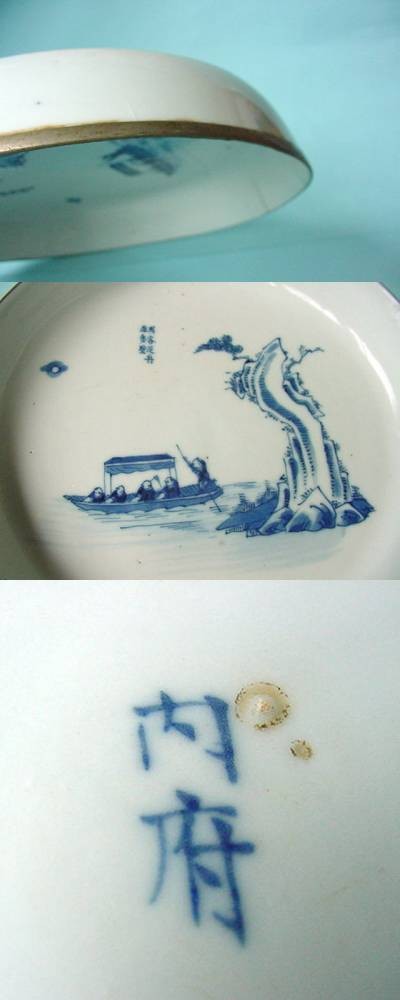
Bleu de Hue. Chinese export porcelain for the Vietnamese market. Mark reads Nei Fu, can be translated as "Inner Court". Mid 19th Century.
The best "Bleu de Hue" was ordered by the Vietnamese court by way of diplomatic missions to China. Most of them were produced in Jingdezhen with special designs and marks. Hue is the name of the old city where the Vietnamese King resided at the time. The designs are special, characteristic and have a slight character of being Japanese instead. Some have poem on them. One common two character mark reads Nei Fu, and can be translated as "Inner Court". Blue de Hue wares were made in China for the Vietnamese dynasties in the 18th and 19th century until after the revolution led by Dr. Sun Yat-sen. At the end of the 19th century metal rims were popular, to protect the rim from damages.
It appears that on most of the court bleu de Hue ware the designs were done by Vietnamese artists. The production was then commissioned in Jingdezhen. But in the nineteenth century, as the middle-class increased in size and economic power it appears as if more Chinese manufacturers, not just at Jingdezhen but at other Jiangxi kilns, saw this potential market and produced pieces independently for it.
Domestic versions of Bleu de Hue were produced locally in Vietnam during the Minh Mang (1820-1841) and Thieu Tri (1841-1847) but they do not seem to have been very popular.
The marks on bleu de Hue are frequently puzzling, the more so when one thinks one can read Chinese. Sometimes they appear to be readily legible, but that can be deceiving, because the meanings derive from adaptations of Chinese script by the scholar Nguyen Thuyen in the thirteenth century. Sometimes the characters are used in the Chinese sense, and sometimes they represent Vietnamese pronunciations or phrases. All very complicated, and therefore an intriguing field of study!
A story has it that in the 1780s the Tay Son regime which overthrew the Ly dynasty sent ambassadors to the Qianlong court to seek Chinese legitimation of their rule. The Qianlong emperor was displeased by their arrogance and sent back gifts of inferior blue and white ware - with runny brushwork and crackled glazes apparently - thereby implying that the Chinese were not impressed.
In Viet Nam the Neifu mark starts around 18th century with King Le-Lord Trinh dynasty. Very high quality porcelain is ordered from China for the court use.
During the Nguyen dynasty (1802-1883), they used the different mark like Minh Mang nien che (Made during the Minh Mang period), Thieu Tri nien che, Tu Duc nien che, Minh (sun), Shou (long life). The decorative motifs is similar as before. Some porcelains appears to have been ordered with other marks for the Princes, Princesses and other with lower ranks still living inside the palace like Ngoc (Jade), Ngoan Ngoc (Jade trinket), Tran ngoan (Precious trinket), ect., but of a high quality.
The Neifu mark appears to start around 1841-1883. After 1883 the Palace did not order any porcelain from China until after 1900. Porcelain was still made in China with the Neifu mark anyway and exported direct to Vietnam. On earlier wares the Neifu mark was not allowed to be used outside of the palace.
The production of porcelain in China has been ongoing until at least the 1940s. Some of the later porcelains with Neifu marks are Japanese and in particular those from 1935-1945 are from Japan, with transfer printed decoration.
Sources: Gotheborg.com Discussion board various authors Bleu de Hue, mostly Trieu Nguyen, 2004.
A